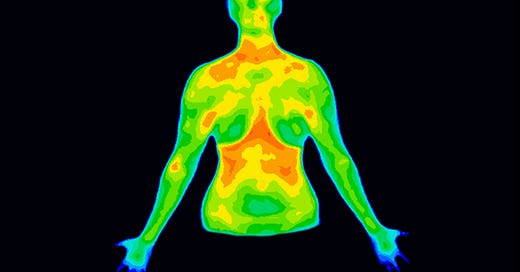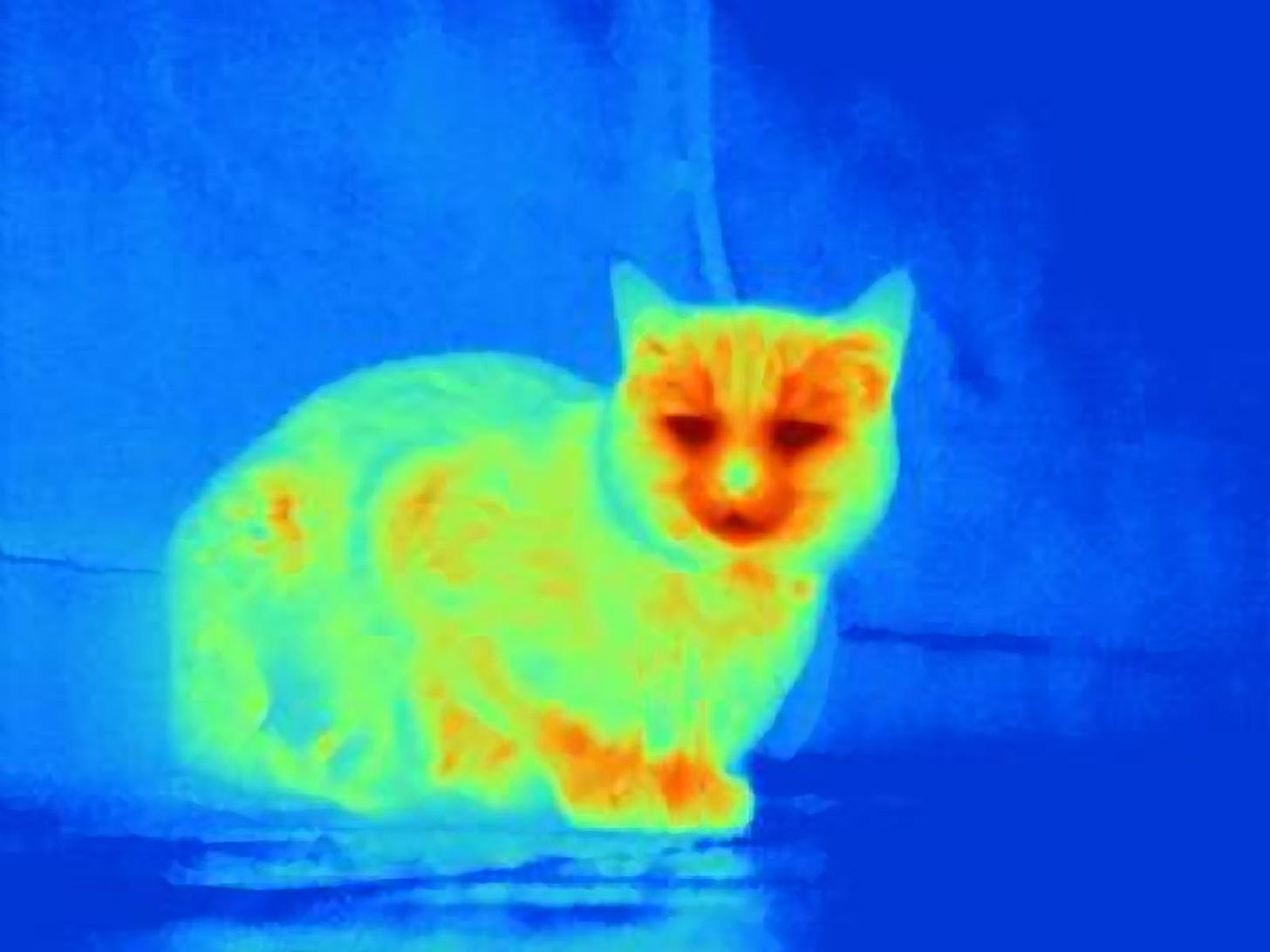Many unproven and potentially harmful alternative medicine practices are like a bad penny; they keep turning up…like a trend (FYI, health care should never be trendy), and yet each time they become “popular” again, there are *still* no studies supporting they work or have any use at all. And one of those scammy practices is breast thermography.
This is one of my major red flags for finding quality medical care. If the person or practice recommends thermography, it’s a shut-the-browser, block, get-up-and-walk-out-the-door moment for me, and it should also be for you.
Here’s why.
What is Thermography?
To understand thermography, we need to back up a little and start with the electromagnetic spectrum of radiation or electromagnetic radiation, which, according to the folks at NASA, “means energy that travels and spreads out as it goes.” We can only see one small part of the electromagnetic spectrum: visible light. But x-rays, radio waves, ultraviolet light, microwaves, and infrared light are all part of the electromagnetic spectrum. Here is a nice graphic from NASA.
Infrared radiation is electromagnetic radiation with a wavelength slightly greater than the red end of the electromagnetic spectrum, just beyond our vision. Infrared radiation is sometimes called “heat radiation” because hot objects emit infrared radiation. If you’ve used night vision goggles or seen one of the Predator movies, you already know a little about using infrared radiation to “see” objects (the Predators have infrared vision). Also, if you haven’t seen Prey, the prequel to Predator, it’s worth watching, and it’s a damn shame it wasn’t released on the big screen!
When objects are hot enough, we can feel the heat and hence their infrared radiation, but even when something isn’t hot enough to feel, it’s still emitting infrared waves. Those can be picked up with special instruments that allow us to see the infrared waves depicted as images. These images are often called thermograms.
Here’s a thermogram of a cat. The nose is relatively cooler, as any cat owner can tell you.
The original hypothesis behind thermography for breast cancer is that cancer cells generally have more blood flow and a faster metabolic rate than other cells/body parts, meaning theoretically they should be warmer and hence *should* show up as hot spots, if you will, on a thermographic image. This heat signal then allows for early detection of breast cancer.
But you deserve more than a hypothesis, you deserve data.
Is Thermography Useful?
Not to you as a patient. Thermography only benefits the person charging you $155 or $375 or whatever large amount for the procedure.
No quality studies support the use of thermography as a screening tool for breast cancer. Thermography also does not pick up breast cancers before mammography, a common piece of rank disinformation promoted by thermogram aficionados. In fact, breast thermography can be harmful because people are seduced into thinking it is a valid screening tool for breast cancer when it isn’t. And so, people get thermography and erroneously think they are fine, only to find out later that they actually had breast cancer and missed out on the opportunity to have it treated earlier.
No medical professional society recommends thermograms for breast screening, including the American College of Obstetricians and Gynecologists, the American College of Radiology, and the Society of Breast Imaging. The Society of Breast Imagine states it “does not currently support the use of thermography/infrared imaging as a screening tool for breast cancer detection or as an adjunctive diagnostic tool.” The American Cancer Society also recommends against thermograms.
Regarding thermography as an alternative to mammography for detecting breast cancers, the FDA states they are “not aware of any scientific evidence to support these claims.” They also state, “There is no valid scientific data to demonstrate that thermography devices, when used on their own or with another diagnostic test, are an effective screening tool for any medical condition including the early detection of breast cancer or other diseases and health conditions.”
Basically, the FDA says thermography is useless for breast cancer detection and, apparently, pretty much everything else.
As an aside note, thermography isn’t effective at reliably identifying someone with a fever! There have been many efforts to use thermography to screen people entering countries or workplaces to identify someone who might have COVID-19 (or another infection, like Swine Flu or Ebola), and the results are pretty dismal. If thermography can’t reliably identify someone who might have a low-grade fever, that seems pretty damning evidence by itself that picking up a heat signal from a tiny breast tumor is biologically implausible.
The FDA has Warned Those Advertising Thermograms for Breast Cancer Detection.
The FDA has issued warning letters against providers and thermography device manufacturers who have advertised thermography as an alternative to mammography. Like this one:
Unfortunately, the only impact seems to be more creative marketing language on the part of the thermography providers. So, instead of claiming thermography can detect breast cancer, the consumer is left with vague language about “breast health,” which only implies it screens for cancer without actually saying it. It duplicitously leads you down that garden path by letting you fill in the blanks yourself. Some awful people even recommend regular thermograms to “monitor breast health,” and when I say regular, I mean every few months! Talk about a money-maker.
Although, it seems many people don’t even care about the FDA warnings. I searched “thermography” on Instagram and did a quick Google search. I found multiple clinics offering it across the United States, all making false claims about it being an effective screening tool for breast cancer.
There is Real Harm Here
I reached out to Dr. Katrina Mitchell, who is a breast surgical oncologist. She told me via e-mail that, sadly, she has “treated countless patients over the years with a “normal thermogram” in the presence of an obvious breast cancer on mammogram, ultrasound, and physical exam.”
Furthermore, Dr. Mitchell told me, “Thermography advocates have perpetuated the myth that mammograms cause cancer from radiation exposure and therefore should be avoided. The truth is that a mammogram incurs less radiation exposure than an airline flight or living at altitude.”
But Isn’t Thermography FDA Approved?
No, thermography is not FDA-approved. Thermography uses a medical device and, as such, cannot be FDA-approved, as medical devices can only be FDA-cleared. Anyone telling you thermography is ”FDA approved” doesn’t know the difference between clearance and approval or doesn’t care to know.
Unfortunately, thermography devices are cleared by the FDA, but only as an “adjunctive” tool alongside a primary screening test like mammography. Thermography devices are Class 1, which means they “present minimal potential for harm to the user.” For comparison, some other class 1 devices are bandages, menstrual pads, and menstrual cups. This means thermography can’t be offered as a stand-alone test but can be offered in addition to mammography. However, no data shows this adds anything to your breast care except an additional fee.
Why is thermography a Class 1 device when it is not useful “for any medical condition?”
It shouldn’t be, especially given what’s going on. It was given Class 1 designation in the early 1980s based on studies that combined it with mammography. Meaning it never had clearance to use as a stand-alone tool. This was all based on studies from the 1970s. Now that we know more, it should lose its Class 1 status.
The FDA wants you to know that thermography is useless and, when prompted, sends out anemic warning letters about false claims. Still, they don’t seem inclined to do anything actionable to protect you against providers making false breast thermography statements.
The “Training” Behind Thermography
Dr. Mitchell pointed out that radiologists interpreting mammograms are “medical physicians who have completed college, four years of medical school, five years of residency.” Those who specialize in breast imaging have also done additional training. They pass exams and must maintain post-training education (we call that continuing medical education).
What kind of training does someone who interprets a thermogram have? It’s not taught in medical or nursing school, so those credentials are meaningless here. According to Dr. Mitchell, “Layperson thermographers require attendance at one meeting or training course, “familiarity” with three thermology textbooks, one exam, and just a few hundred clinical cases.”
What Can You Do?
Do not get thermography! And friends don’t let friends get thermography!
Think twice about seeing a provider who offers thermography. Do you really want to trust your health to someone charging a lot for what essentially amounts to a parlor trick?
Thinking about buying a book on women’s health or health in general? Google the author and “thermography.” If they recommend it, don’t support them in any way. If they recommend thermography, you are not missing out on anything valuable.
If you see anyone making false claims about thermography, or you yourself have been duped, consider filing reports with the FDA and the Federal Trade Commission (if you are in the United States).
If you are enraged, I can only suggest contacting your Congressional Representative and State Senator. You’d think protecting people from breast cancer profiteers would be good for votes!? You could also contact your state-level political representative to see what laws could be or have been enacted in your state to protect the public. I’ve decided to contact my politicians to see what can be done.
There is something deeply wrong with a system that allows thermography devices to be sold and used, even though the FDA states they are not recommended for cancer screening and every medical society recommends against them.
It should be a slam dunk for the FDA to reclassify thermography as a Class III device (meaning studies and a different level of clearance are actually required for use) and for politicians to enact laws to eliminate thermography for breast screening outside of valid clinical studies and to enact heavy fines for those who flout the laws. You’d think protecting people from breast cancer screening scams that the FDA and all medical experts warn against should be an easy bipartisan bill.
Let’s end with some words from Dr. Mitchell, who deals with the fallout from thermography on a regular basis, “Women deserve better than this.”
References
Brenner RJ, Parisky Y. Alternative breast-imaging approaches. Radiol Clin North Am. 2007 Sep;45(5):907-23, viii. doi: 10.1016/j.rcl.2007.06.006. PMID: 17888777.
Khaksari K, Nguyen T, Hill B, Quang T, Perreault J, Gorti V, Malpani R, Blick E, González Cano T, Shadgan B, Gandjbakhche AH. Review of the efficacy of infrared thermography for screening infectious diseases with applications to COVID-19. J Med Imaging (Bellingham). 2021 Jan;8(Suppl 1):010901. doi: 10.1117/1.JMI.8.S1.010901. Epub 2021 Mar 25. PMID: 33786335; PMCID: PMC7995646.








Thank you for explaining this so well!
Hi Jen and thanks so much for all your fantastic posts. Two things I would love to hear more about your thoughts on: firstly Dr Mitchell states that the claim mammograms cause cancer is false and that the radiation dose is very small. My understanding is that although the dose is indeed small, regular mammograms DO cause a very small number of additional breast cancers, it’s just that this small number is outweighed by the number of lives saved via early detection. Still, important information..
Second, while mammograms remain a recommended screening tool around the world and save many lives via early detection, the issue of over diagnosis has been raised by reputable experts. Basically by detecting very early cancers we treat women whose cancer would never progress without treatment. Love to hear your thoughts. Warmly, Rosie